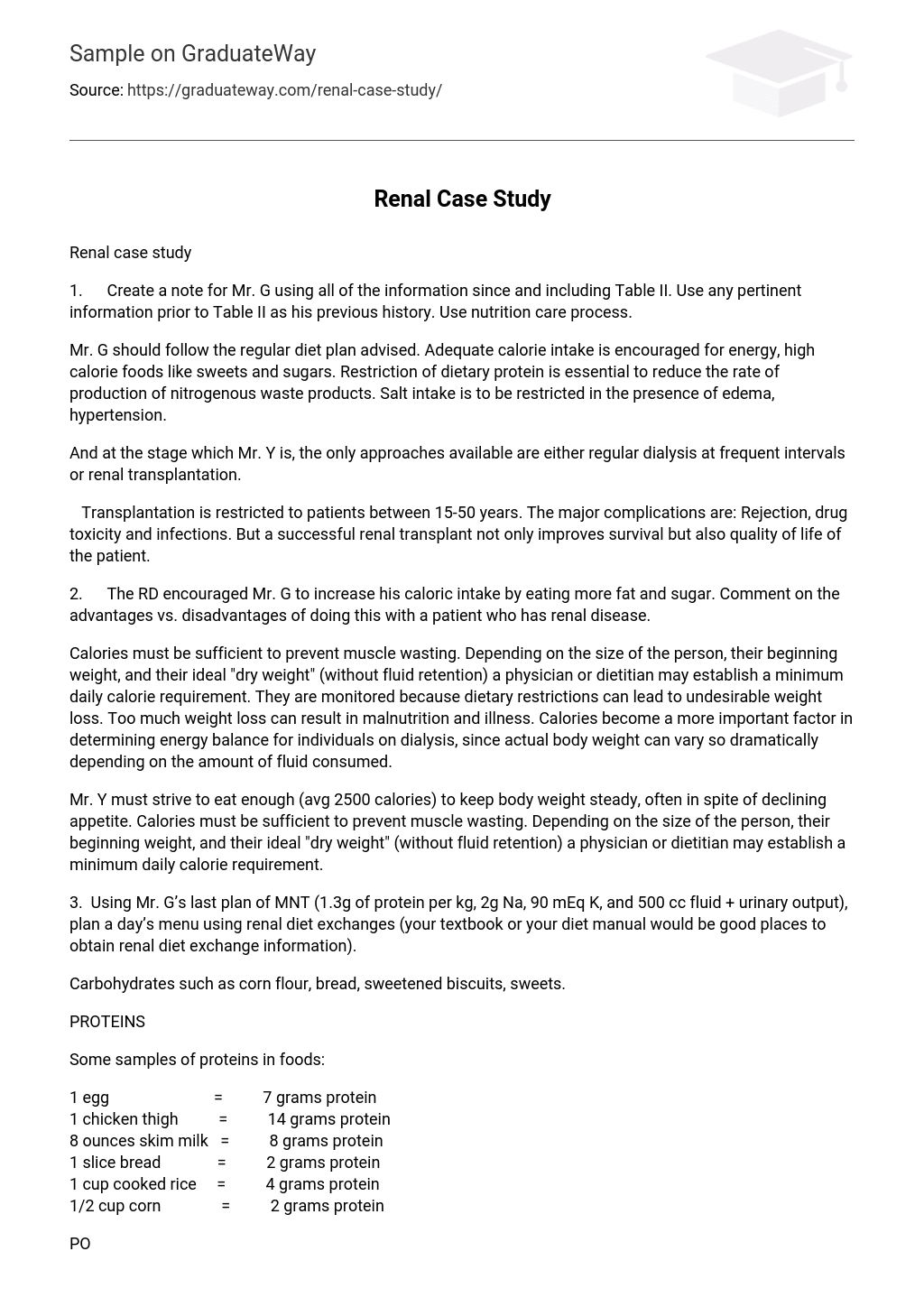Renal case study
1. Create a note for Mr. G using all of the information since and including Table II. Use any pertinent information prior to Table II as his previous history. Use nutrition care process.
Mr. G should follow the regular diet plan advised. Adequate calorie intake is encouraged for energy, high calorie foods like sweets and sugars. Restriction of dietary protein is essential to reduce the rate of production of nitrogenous waste products. Salt intake is to be restricted in the presence of edema, hypertension.
And at the stage which Mr. Y is, the only approaches available are either regular dialysis at frequent intervals or renal transplantation.
Transplantation is restricted to patients between 15-50 years. The major complications are: Rejection, drug toxicity and infections. But a successful renal transplant not only improves survival but also quality of life of the patient.
2. The RD encouraged Mr. G to increase his caloric intake by eating more fat and sugar. Comment on the advantages vs. disadvantages of doing this with a patient who has renal disease.
Calories must be sufficient to prevent muscle wasting. Depending on the size of the person, their beginning weight, and their ideal “dry weight” (without fluid retention) a physician or dietitian may establish a minimum daily calorie requirement. They are monitored because dietary restrictions can lead to undesirable weight loss. Too much weight loss can result in malnutrition and illness. Calories become a more important factor in determining energy balance for individuals on dialysis, since actual body weight can vary so dramatically depending on the amount of fluid consumed.
Mr. Y must strive to eat enough (avg 2500 calories) to keep body weight steady, often in spite of declining appetite. Calories must be sufficient to prevent muscle wasting. Depending on the size of the person, their beginning weight, and their ideal “dry weight” (without fluid retention) a physician or dietitian may establish a minimum daily calorie requirement.
3. Using Mr. G’s last plan of MNT (1.3g of protein per kg, 2g Na, 90 mEq K, and 500 cc fluid + urinary output), plan a day’s menu using renal diet exchanges (your textbook or your diet manual would be good places to obtain renal diet exchange information).
Carbohydrates such as corn flour, bread, sweetened biscuits, sweets.
PROTEINS
Some samples of proteins in foods:
1 egg = 7 grams protein
1 chicken thigh = 14 grams protein
8 ounces skim milk = 8 grams protein
1 slice bread = 2 grams protein
1 cup cooked rice = 4 grams protein
1/2 cup corn = 2 grams protein
POTASSIUM
Potassium is not usually restricted until urine output begins to decrease. Sometimes people with diabetes may need to have potassium limited.
Foods high in potassium are:
Bananas, Oranges, Orange Juice, Milk, Prunes, Prune Juice, Tomato Juice, Tomato Sauce, Nuts, Chocolate, Dried Peas and Beans
SODIUM
High sodium foods to avoid include:
Salt, Bacon, Ham, Corned Beef, Pepperoni, Sausage, Pizza, Chinese Food, Fast Foods, Pickles, Cheese, Soy Sauce, Canned Soups, Potato Chips, Fritos, Cheetos
Breakfast can be a serving of steak or burger and eggs (an omelet made with three whites and one yoke, perhaps), fruit selected from the low potassium list, a slice of toast with jam.
Wheat, rice, and corn cereals work either hot or cold. Potatoes can be included rarely if they have been soaked overnight before cooking. (The foam that rises to the top of the soaking pot is the potassium leaching out of the potatoes into the water, which must be discarded.) White rice (not brown) can take the place of hash browns.
Lunches and dinners should sliced roast beef, poultry, well-rinsed tuna, or fish with a salad of iceberg lettuce (lower potassium than loose leaf) with a selection of carefully chosen fresh or canned vegetables. A fruit salad in a base of non-dairy whipped topping, made with canned fruits.
BREAKFAST
• 1/2 cup (4 ounces) orange juice• 1 English muffin or 2 slices bread
• At least one tablespoon margarine with jelly
• Coffee or tea with non-dairy creamer and sugar
SNACK
• 2 canned pear halves in heavy syrup
LUNCH
• 2 slices white bread • At least 2 tablespoons mayonnaise with lettuce and tomato
• 1 ounce chicken (such as a small thigh) or 1 hard boiled egg
• 2 canned peach halves in heavy syrup
• 7-UP, lemonade or Hawaiian Punch
SNACK
• Baked apple with 1/2 cup non-dairy whipped topping
DINNER
• 3-4 ounces steak (weigh after cooking, without bone) , sauté in tablespoons olive oil
• 1 small baked potato with at least 2 tablespoons margarine
• 1/2 cup fresh green beans, carrots or broccoli with margarine
• Lettuce, onions, cucumbers, green pepper
• At least 2 tablespoons olive oil with vinegar or lemon
• 1/8 apple or cherry pie with 1/2 cup fruit sorbet (this is not sherbet)
• Iced tea with sugar and lemon or Sprite
SNACK
• 1 small banana and 10 vanilla wafers
• Coffee or tea with non-dairy creamer and sugar
NOTE: THESE ARE GENERAL GUIDELINES AND MENU. SPECIFIC MENUS OR FOOD CHOICES SHOULD BE MADE ON THE RECOMMENDATION OF A NUTRITIONIST OR PHYSICIAN.





